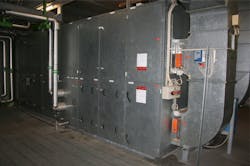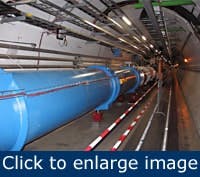Control and supervisory software creates big bang at CERN
CERN, the European Organization for Nuclear Research (www.cern.ch), is one of the largest scientific research centers in the world. The particle accelerator and detector instruments used in the laboratory study the physics of the universe to understand its makeup. The Large Hadron Collider (LHC) project, located in Geneva near the Franco-Swiss border, commenced in the fall of 2008 and is the world’s largest and highest-energy particle accelerator.
The objective of the LHC is to uncover some of the most fundamental questions of physics. The LHC accelerates protons from the hadron family, allowing physicists to study some of the smallest known particles. To accomplish this, two beams of hadrons or heavy ions circulating in opposite directions are accelerated in a 17-mile (27-km) ring to reach a speed close to the speed of light at very high energy levels. When these particles enter into head-on collision, the shock generated makes it possible, for example, to reproduce conditions close to those that occurred just after the Big Bang. The particles these collisions produce are analyzed by special detectors delivering data that are interpreted by researchers from more than 100 countries. This is why the monitoring and tracking of the various components of the LHC is so critical. Experiments are monitored closely to ensure every process is optimized and every piece of equipment is achieving peak performance.
To perform these complex, large-scale experiments, the LHC requires a minimum of 9,300 magnets cooled to -458° F (-271.3° C) by 10,080 tons of liquid nitrogen and 60 tons of liquid helium delivered via a cryogenic distribution system. This installation also requires a ventilation system sized to establish an atmosphere suited to both personnel and the equipment located in the experimental zones. In addition, the LHC’s ventilation provides the cold smoke extraction and pressurization functions in the underground survival zones.
To facilitate and manage its ventilation and cooling facilities, CERN required a control and supervisory software package that would suit the enormous size of this application, which houses more than 200 pieces of automation equipment.
In the architecture CERN adopted, the number of clients able to connect to the system is 28 (eight fat clients and 20 terminal server clients), which means that it must operate virtually in real-time. With an extremely high availability constraint, redundancy enables one server to take over if another is no longer available.
CERN chose the PcVue SCADA supervision software ARC Informatique developed and installed on-site by Assystem France to monitor and control its ventilation systems and the 200 associated programmable controllers.
[pullquote]The SCADA system monitors some 80,000 I/O points for the LHC’s cooling and ventilation application. They’re monitoring everything from pressure to temperature to water levels to provide a secure, safe and comfortable environment for the workers in the facility.
Siemens provides the PLCs being used in the LHC’s network. CERN has mainly used its S7-200 and S7-300 models. PcVue is connecting to the PLCs via industrial Ethernet and Profibus through an OPC server connection.
Initially, the supervisor performs data acquisition activities and the collected data is sent to its information system for further analysis. Operators and management use the SCADA not only to conduct supervision but also to operate, view, act on and diagnose the control process. It provides a global overview of the data.
PcVue collects and processes data, displaying certain assigned data points in PcVue SCADA’s animated displays otherwise known as mimics. The SCADA uses object-oriented technology that allows the developer to assign specific data points to objects and save them to a library for reuse. CERN found PcVue’s graphical user interface extremely user-friendly when developing 1,200 mimic displays and 600 objects in the SCADA. Developers and engineers can configure screens. Most user interfaces use a tree structure method in the configuration process. PcVue takes a different graphical approach, developing a configuration environment to produce real-time animation that allows graphical objects to be replicated and reused. The configuration technology is built into the SCADA for visualization of processes and real-time data and has provided CERN integrators a way to develop applications.
PcVue also supports the VMware virtual environment. The virtual arrangement is designed to allow several operating systems to run independently from each other on a single machine as if they were running on separate physical machines. “Given the scale of the LHC's application, the implementation of a virtual infrastructure led to a drastic reduction in the number of physical machines used, lower power consumption and excellent integration in CERN's IT architecture,” points out Lionel Diers from Assystem France.
The end result of this virtualization is that the LHC’s ventilation supervision system requires only two physical machines. Each has 12 GB RAM and six 250 GB hard drives. The workload also is shared between the redundant physical servers. The first PcVue server allows functionality of the Web server, for users to connect online and the database server, which holds the data, while the second PcVue server maintains the terminal server.
Eight on-site monitoring stations are distributed one per experimental area. Each station is equipped with a touchscreen for the local maintenance operators to use. These stations are critical and are set up as intervention areas. They’re located about 1.25 miles apart and permit access allowing the user to control the ventilation installations in the event of an emergency or any critical problem that would need to be addressed in a timely manner.
PcVue, Assystem France, and CERN cooperated in the past, finding complementary working styles. “The responsiveness of the service and competence of technical support with respect to the end users’ needs have proven beneficial,” explains CERN’s Mario Batz, project leader in the CERN engineering department's cooling and ventilation group. “And with more than 40,000 licenses installed to date, that’s a pretty powerful experience.”


